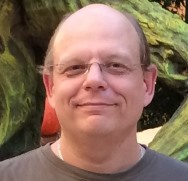Michael Hendzel

Michael Hendzel
Ph.D., University of Manitoba
Adjunct Professor
Office: 6-30 Medical Sciences BuildingLaboratory: 6-32 Medical Sciences Building
Telephone: 780-492-4990 / 780-432-8439
Fax: 780-432-8892
michael.hendzel@ualberta.ca
Structure, Dynamics, and Function in the Cell Nucleus
My laboratory is interested in the chromatin and nonchromatin structures of the cell nucleus, their dynamics, and their relationship to the major functions executed by the cell nucleus (transcription, mRNA processing, DNA replication, DNA repair). To study these processes, we employ a range of microscopy, biochemistry, and molecular biology techniques.
Nuclear compartments and their function
It has been known for quite some time that the nucleus is not a homogeneous mass of DNA interspersed within a membrane-bound volume. Instead, both the genome and non-chromatin structures of the interphase nucleus are commonly seen to concentrate in discrete sites within the nucleus. These sites are generally referred to as nuclear compartments or nuclear bodies. While their composition and dynamics is increasingly understood, understanding their function has been more of a challenge. In order to get a better understanding of how compartmentalization regulates function, we are employing the formation of compartments around DNA double-strand breaks. These compartments are commonly referred to as ionizing radiation-induced foci despite being dependent on the type of damage (double-strand break) rather than the source of damage (ionizing radiation). For example, these compartments can also be induced using restriction endonucleases to introduce the double-strand break.
The Ataxia telangiectasia mutated (ATM) kinase is responsible for much of the kinase signaling that takes place in response to DNA double-strand breaks. The kinase is inactive in the absence of DNA damage and becomes active and autophosphorylates on serine 1981 when double-strand breaks are present. Following the induction of double-strand breaks, the ATM kinase enriches in the compartments that form around DNA double-strand breaks. We have found conditions where we are able to induce double-strand breaks and activate the ATM kinase but prevent the ATM kinase from enriching in these compartments. We know that, under these conditions, at least some of the ATM substrates are utilized. The vast number of characterized ATM substrates is allowing us to quantitatively determine the contribution of compartmentalization to the phosphorylation of ATM substrates and the execution of ATM functions.
Development of "colour" transmission electron microscopy
The contribution of light microscopy to our understanding of cell structure took a major leap forward when the appropriate antibody and nucleic acid probes and fluorescent labels became available. This allowed individual proteins and nucleic acids to be studied at the single cell level. Something similar is possible in transmission electron microscopy by using the "energy loss" spectrum instead of the wavelength spectrum of light. When the electron beam of the transmission electron microscope passes through the specimen, some of the electrons collide with inner shell electrons of the individual elements where the specimen element becomes ionized and the incident electron loses energy. The amount of energy lost depends on the element that the incident electron has ionized since the ionization energy for the electrons are defined. This type of transmission electron microscopy, termed electron spectroscopic imaging (ESI), is already a very useful technique for studying the cell nucleus. Both the phosphorus and nitrogen elements of the specimens generate strong signals that can be imaged. Because the phosphorus is so much more abundant in nucleic acid than nitrogen whereas proteins contain much less phosphorus relative to the nitrogen, the technique is particularly good at studying nucleic acids and looking at protein interactions with DNA or RNA. We are collaborating with the Wuest laboratory in the Department of Oncology, University of Alberta, to develop fluorinated and boronated probes, such as antibodies and modified nucleotides, in order to bring colour to the transmission electron microscope. We anticipate being able to visualize transcription directly in the transmission electron microscope, something that has only been possible in a model organism and information that is lacking with respect to structure-function relationships in the cell nucleus of mammals.
Other
We have additional research projects in the laboratory that pertain to the contribution of chromatin remodeling proteins with chromatin at sites of DNA double-strand breaks. We are particularly interested in the Polycomb repressive complex 1, which is a histone H2A E3 ubiquitin ligase and participates in both developmental gene silencing and DNA double-strand break repair. Evidence currently supports the hypothesis that the high expression of this complex in stem cells and cancer stem cells increases the resistance of cancer stem cells to DNA damage-inducing therapies.
Selected publications
McDonald, D., G. Carrero, C. Andrin, G. de Vries, and M.J. Hendzel, Nucleoplasmic beta-actin exists in a dynamic equilibrium between low-mobility polymeric species and rapidly diffusing populations. Journal of Cell Biology, 2006. 172(4): p. 541-552.
Ismail, I.H., C. Andrin, D. McDonald, and M.J. Hendzel, BMI1-mediated histone ubiquitylation promotes DNA double-strand break repair. Journal of Cell Biology, 2010. 191(1): p. 45-60.
Hendzel, M.J., The F-act's of nuclear actin. Curr Opin Cell Biol, 2014. 28C: p. 84-89.
Raghuram N., H. Strickfaden, D. McDonald, K. Williams, H. Fang, C. Mizzen, J.J. Hayes, J. Th'ng, and M.J. Hendzel Pin1 promotes histone H1 dephosphorylation and stabilizes its binding to chromatin. J Cell Biol, 2013. 203(1): p. 57-71.
Ismail, I.H., R. Davidson, J.P. Gagne, Z.Z. Xu, G. Poirier, and M.J. Hendzel, Germ-line Mutations in BAP1 Impair its Function in DNA Double-Strand break Repair. Cancer Res, 2014.
Strickfaden, H., Z.Z. Xu, and M.J. Hendzel. 2015. Visualization of miniSOG Tagged DNA Repair Proteins in Combination with Electron Spectroscopic Imaging (ESI). J Vis Exp.
Ismail, I.H., J.P. Gagne, M.M. Genois, H. Strickfaden, D. McDonald, Z. Xu, G.G. Poirier, J.Y. Masson, and M.J. Hendzel. 2015. The RNF138 E3 ligase displaces Ku to promote DNA end resection and regulate DNA repair pathway choice. Nat Cell Biol. 17:1446-1457.
Ali, M.A.M., H. Strickfaden, B.L. Lee, L. Spyracopoulos, and M.J. Hendzel. 2018. RYBP Is a K63-Ubiquitin-Chain-Binding Protein that Inhibits Homologous Recombination Repair. Cell Rep. 22:383-395.
Laboratory Members
Technician
Darin McDonald
Research Associates
Dr. Zhigang Jin
Dr. Hilmar Strickfaden
Postdoctoral Fellows
Dr. Faissal Ouenzar
Dr. Ajit Sharma